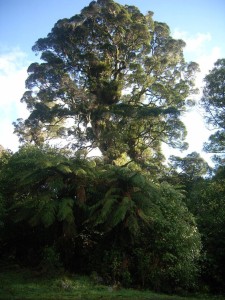
Wellington's water supply: building reservoirs on earthquake faultlines
Visiting this earthcache will have the mandatory brief lesson in earth sciences, and is a great place to visit. You are likely to be in the area to log the nearby historic GC46, but make the effort to come up to this spot too. It's in a beautiful quiet location you might not otherwise visit, and public access has only been allowed since 2013. There are picnic tables and the walk in is easy.
At this site I want you to reflect on the way that the landscape we see today is often created by the interaction over time of geology and man. In New Zealand, land of many stunning landscapes and land forms, we often see mother nature in her raw state, with geology simply dictating shapes and vegetation. Here, at Wainuiomata lower dam, we see how man altered the physical shape of the landscape, but later, geological forces compelled man to change the relationship with nature. Did those early engineers appreciate that building a dam across a fault line was unwise?
Rupture of the Wellington Fault, (which passes close to the Wainuiomata Valley) would cause a variety of major earthquake hazards. The impact of the ground shaking at any site depends on three major factors:
1. The size and depth of the earthquake - this determines the frequency and amplitude (strength) of the seismic waves as they travel through the earths crust.
2. The underlying rocks – for example, soft and less consolidated sand and gravel sediments will behave differently to older and harder sanstones such as greywacke and argilite.
3. The type of structure vulnerable to shaking.
Additionally, many slips would occur throughout the region, especially if the hill slopes are already saturated by recent rainfall. In flat areas underlain by unconsolidated sediments the ground can liquefy, tilting buildings and causing buried pipelines and other structures to float to the surface.
So, let's start with some history.
The Wainuiomata dam was constructed between 1880 and 1884 to provide water to Wellington. The construction material had to be hauled over Wainuiomata Hill (where there is now a 4-lane highway) and a tunnel had to be dug through the hill to get the water to Wellington through 27km of pipeline. It is one of the oldest dams in New Zealand and originally held just 122 million litres of water, an amount so small it could have been emptied in just a day. In the 1950s, the dam was taken out of service for water supply purposes.
A geological survey of the Wainuiomata valley was done in 1993 with a stratigraphic drillhole. The deep greywacke and argilite rocks were found to be overlain by more than 60 metres of much younger and softer quarternary sediments from the Pleistocene era.
The dam is either unreinforced or there is minimal reinforcing, so vulnerable to seismic shaking. In 2004 a review of safety of the dam and associated infrastructure was undertaken as a result of higher dam safety guidelines. Investigations revealed that:
• The dam had a low potential impact category. That is, if the dam were to breach, the residential population downstream of the dam would not be in significant danger.
• The present spillway had sufficient capacity for a low impact category dam.
• The upstream concrete wall was extremely vulnerable to earthquake shaking and required strengthening or supporting in order to withstand earthquake loads.
• The instability of the upstream concrete wall during earthquake loading means that continuing to operate the dam as at present with the lake normally dewatered was not a viable long-term solution for this dam. A earthquake could cause the embankment material behind the concrete wall to scour out, after the event.
It was therefore concluded that upgrading of the dam was necessary for the dam to comply with Dam Safety Guidelines. Various upgrade options were considered, but the chosen solution was the option of lowering the spillway. This achieved a number of objectives. It retains a significant part of the original structure. Following a major earthquake, the dam wall might fail but because of a relatively low water level, there would not be any significant consequent risks.
Decomissioning the dam has allowed the reservoir to be transformed into a shallow lake and wetlands, home to native birds including kereru, bellbirds, tui and paradise ducks. Public access to the dam was prohibited for 129 years until March 2013 after years of regeneration work by the Greater Wellington Regional Council.
Your task is to answer the following questions.
1. What surface geology is found at this site? (The answer is implied in the text above - no need to be too detailed.)
2. How does this rock differ from that of the hills surrounding Wellington?
3. Where is this rock most easy to identify in the region of the dam and its environs?
4. (Optional) Post a picture of yourself looking out to the wetlands from the dam.
Log a find after sending me the answers, but don't wait for my reply before you log the find. Enjoy the walk and the picnic tables! We enjoyed this valley and recreation area we came here in January 2018 on our second visit to NZ from the UK. By establishing an earthcache here we have the chance to revisit the site through your photos!